From beginner to elite, this fin:
• turns easier,
• accelerates quicker, &
• is more forgiving
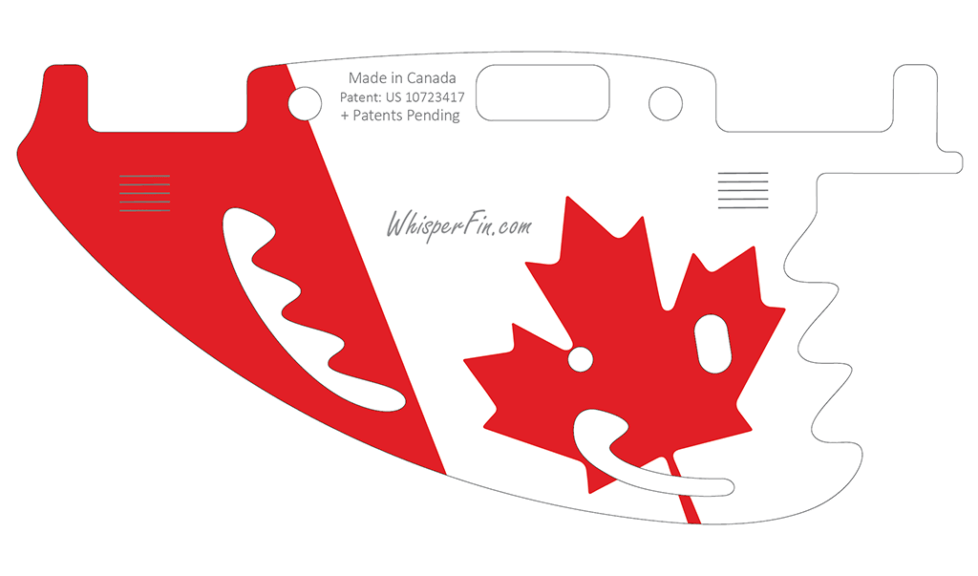
• turns easier,
• accelerates quicker, &
• is more forgiving
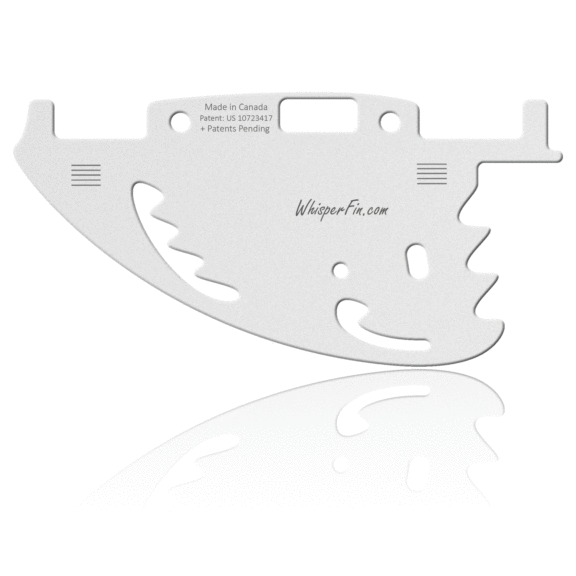
When a water ski’s tail is sliding sideways around a turn, turbulent eddies that form on the low-pressure side at the back of the fin can cause cavitation. Fin cavitation shows up as tail slides, tip-grabs and blowouts while turning at max lean angles. This phenomenon is why all standard fins have holes drilled through them. But these holes create a lot of drag and lose their effectiveness at extreme angles causing the tail to let go when grip is needed most.Tail-grip that deminishes with increasing angle requires the standard fin to be bigger than ideal, and that it be tuned for our hardest passes. These big-fin setups make turning during easier passes more difficult than necessary, which of course is no problem for pros. Amateurs, on the other hand, struggle to perform well with most of the factory setups recommended by pro skiers. Ideally, the fin should be easy to turn during any pass, and it should retain consistent grip as lean angles get more extreme—for pros and amateurs. The patent pending chevrons at the back of the WhisperFin PRO organize the wake behind the fin in ways that minimize cavitation and drag. And by angling the chevrons upward, the more the tail slides the more grip the fin generates, maximizing tail support when you need it most—during high-speed, tight turns caused by the late, narrow preturns of your hardest passes.This unique trailing edge increases tail-hold so much, the fin can be run .030” to .040” shallower than the original WhisperFin. And this reduced fin area improves turn-initiation at the ball, and reduces tip-rise out of turns.If none of this makes any sense to you, all you need to know is that this fin maintains the easy-turning quick-accelerating nature of the original WhisperFin, plus adds noticeably more consistency and composure than any other fin when pushed to extremes. The phrase most shared by testers has been, “I can’t believe what I just got away with.”
The patent pending chevrons at the back of the WhisperFin PRO organize the wake behind the fin in ways that minimize cavitation and drag. And by angling the chevrons upward, the more the tail slides the more grip the fin generates, maximizing tail support when you need it most—during high-speed, tight turns caused by the late, narrow preturns of your hardest passes.This unique trailing edge increases tail-hold so much, the fin can be run .030” to .040” shallower than the original WhisperFin. And this reduced fin area improves turn-initiation at the ball, and reduces tip-rise out of turns.If none of this makes any sense to you, all you need to know is that this fin maintains the easy-turning quick-accelerating nature of the original WhisperFin, plus adds noticeably more consistency and composure than any other fin when pushed to extremes. The phrase most shared by testers has been, “I can’t believe what I just got away with.”

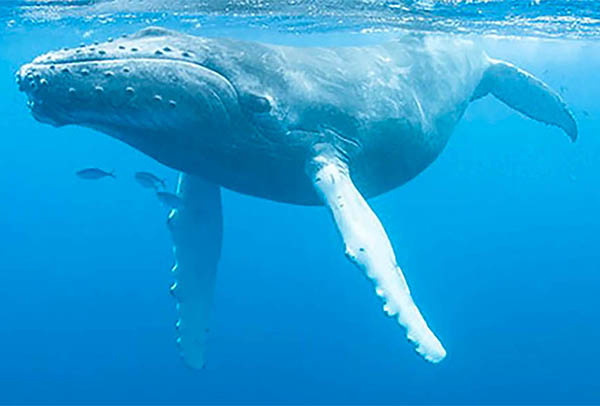 The strip of turbulators at the front of the WhisperFin act like the tubercles/bumps along the leading edge of a humpback whale’s pectoral fins. These tubercles improve water flow across their fins so much, they can swim maneuvers that defy their size. This seemingly impossible maneuverability lead to research that in turn inspired performance improvements to, among other things, helicopter blades, wind turbines, and Formula One race car wings.This method of improving water flow across the low pressure side of the WhisperFin reduces drag and gives it more power. And some of this added power can be traded for the benefits of reducing the fin’s size, leading to other performance enhancements.
The strip of turbulators at the front of the WhisperFin act like the tubercles/bumps along the leading edge of a humpback whale’s pectoral fins. These tubercles improve water flow across their fins so much, they can swim maneuvers that defy their size. This seemingly impossible maneuverability lead to research that in turn inspired performance improvements to, among other things, helicopter blades, wind turbines, and Formula One race car wings.This method of improving water flow across the low pressure side of the WhisperFin reduces drag and gives it more power. And some of this added power can be traded for the benefits of reducing the fin’s size, leading to other performance enhancements.

It may seem obvious that a smaller fin would be easier to turn, but there’s more to it than that. The standard water ski fin is so inefficient it has to be big to achieve the hold and power needed by advanced skiers. The WhisperFin’s patented design allows it to be smaller and easier to turn while actually increasing its power to accelerate.While easier turn initiation is beneficial to all skiers, it’s hugely helpful for novice skiers. And for advanced skiers, reducing fin size also makes it easier to keep the ski’s tip down and engaged with the water while transitioning out of turns into the cut. Not having to wrestle with turn-finish wheelies makes it easier to ski earlier and wider in the slalom course, leading to shorter ropes and higher ball counts.

The less the fin flexes, the more linear tail behavior is while the ski rolls in and out of turns. This is because a soft fin flexes most as it transitions through mid-roll angles, making the ski’s tail “catch” then “snap-release” as the ski rolls up onto its steepest edge where the fin unloads. Then as the ski is rolled off its edge exiting the turn, the fin catches again as it abruptly flexes in response to its increased side loading, exaggerating turn-exit wheelies. The original WhisperFin was machined out of stiff 6061-T6 aluminum billet, a big upgrade over the usual sheet aluminum used for fins. The WhisperFin PRO has been further upgraded to aerospace grade 7075-T651 aluminum for over 50% more strength, improving tail consistency through the full roll range.
The original WhisperFin was machined out of stiff 6061-T6 aluminum billet, a big upgrade over the usual sheet aluminum used for fins. The WhisperFin PRO has been further upgraded to aerospace grade 7075-T651 aluminum for over 50% more strength, improving tail consistency through the full roll range.
Placing chevrons along trailing edges to achieve flow efficiencies is not a new idea. In fact, it’s the product of millions of years of evolution where survival depends on competitive advantages. Here are some examples of this competitive evolution from nature, aerospace and motors ports.
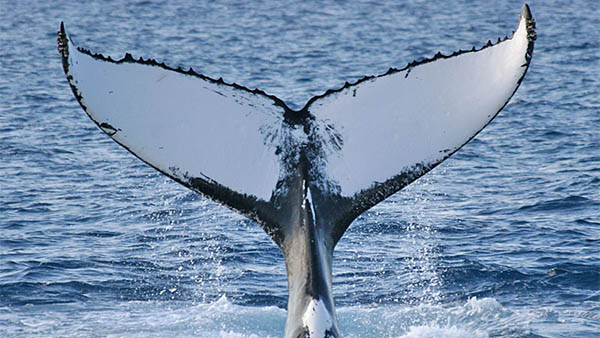
Logging distances as far as 16,000 miles through the world’s oceans, the humpback whale is among the longest migrating animals on earth. 50 million years of evolution put chevrons on the trailing edge of this 40 ton marathoner.
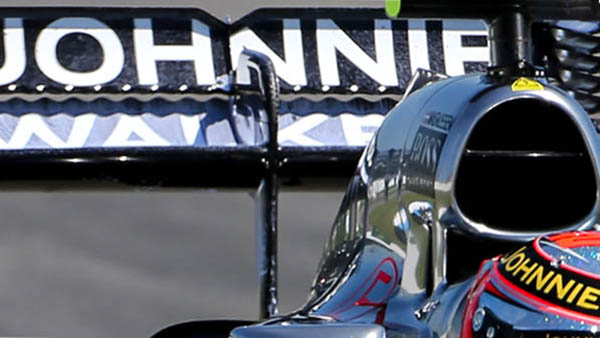
The main plane of this rear wing on the Mercedes F1 car uses trailing edge chevrons to reduce turbulent eddies behind the wing. Note the similarity of the upper wing’s leading edge to the front turbulators on WhisperFins.

The yellow circles highlight the front dive planes on Fernando Alonso’s World Championship-winning Le Mans car. The trailing edge shape is engineered to efficiently generate downforce with minimal drag.
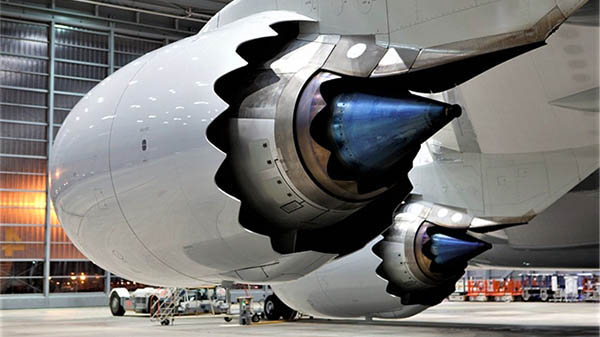
As high speed trust merges with slower air flows behind a jet engine, the resulting turbulence creates a lot of noise. This noisy turbulence is significantly reduced by using chevrons to organize these converging flows.
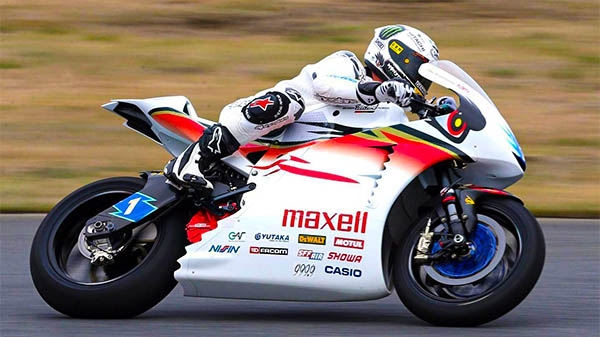
The fastest motorcycle race on earth is the Isle of Mann TT. This Mugen Shinden entry is the first to show up with trailing edge chevron technology as part of their quest for less drag and higher speed.

Wind tunnel testing developed a windscreen that reduces turbulence buffeting the driver’s helmet. Less turbulence behind the WhisperFin PRO’s chevrons make it more stable when near the limits of its grip.
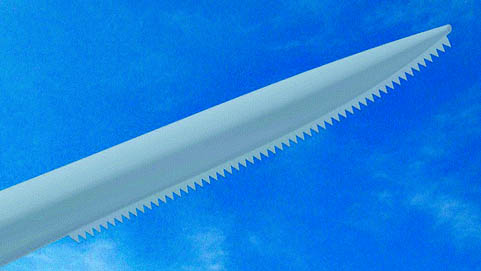
High pressure air flowing over one side of the blade collides turbulently with the low pressure air flowing over the other side of the blade. Adding serrations to the trailing edge reduces noise and boosts efficiency by blendingthese two flows together more smoothly.
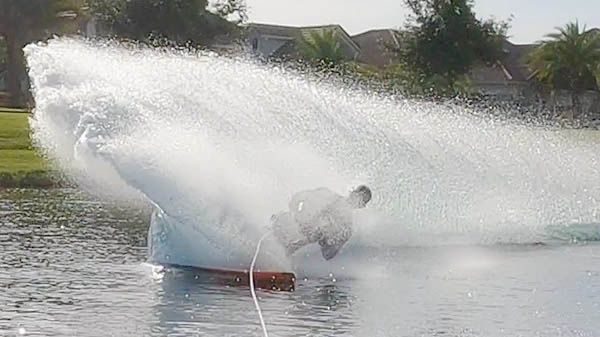
Blowing the tail out of the water is mostly caused by rotating so much tip into the water that it levers the tail up and out of the water. This ski’s tip has been driven about as deep as it can go, and the WhisperFin PRO still has holding power to spare … mic drop
The bottom line is that this patent pending trailing edge is not a gimmick. It’s a genuine performance advancement, an advancement that good skiers feel in their harder passes, and an advancement that produced PBs right from the start of prototype testing.And this performance advantage isn’t just for advanced skiers. More customers have purchased WhisperFins on the advice of their professional ski coaches than for any other reason. And that’s because it’s easier to work on your technique with a dance partner than with a wrestling opponent.